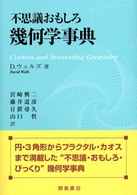- ホーム
- > 洋書
- > ドイツ書
- > Mathematics, Sciences & Technology
- > Chemistry
Full Description
Muon Spin Spectroscopy An introduction to muon spin spectroscopy with a focus on applications in chemistry and materials science
Muon Spin Spectroscopy: Methods and Applications in Chemistry and Materials Science delivers a robust and practical discussion of the areas in muon spin spectroscopy most relevant to chemistry and materials science. In this text readers will find the background details of muonium chemistry, as well as descriptions of applications in a variety of topics of varying complexity, from chemical reactivity in the gas phase to condensed matter and biological systems.
The text covers material ranging from the historical background to recent technological and theoretical developments in the field. Readers will also find:
An introduction to muon beams and spin spectroscopy, including discussions of spin polarization and muon decay
Comprehensive explanations of the formation of chemical states incorporating muons
Practical discussions of chemical reactivity and dynamics testing rate theory in the gas phase, including the influence of the potential energy surface
Comprehensive treatments of muoniated free radicals, spin relaxation studies, and muonium chemistry and chemical kinetics in condensed phases
Ideal for practicing spectroscopists, physical chemists, and surface chemists, Muon Spin Spectroscopy: Methods and Applications in Chemistry and Materials Science will also benefit students of materials science and chemistry.
Contents
Preface ix
1 Perspective and Introductory Remarks 1
1.1 What Do Muons Bring to Chemistry? 1
1.2 Muon Facilities and Background to Experimental Muon Techniques 4
1.3 The Development of Muonium Chemistry 5
References 8
2 Muon Beams and Spin Spectroscopy 11
2.1 Spin-Polarized Muon Beams 11
2.2 Muon Decay and Detection of Its Spin Polarization 13
2.3 Continuous Versus Pulsed Muon Beams 14
2.4 μSR Spectrometers 16
2.5 Spectroscopy of Muons in Diamagnetic Environments 18
2.5.1 Diamagnetic Muons in a Longitudinal Field 18
2.5.2 Diamagnetic Muons in a Transverse Field 19
2.5.3 Diamagnetic Muons in Zero Magnetic Field 22
2.6 Spectroscopy of Muonium 23
2.6.1 Muonium in a Transverse Field 24
2.6.2 Muonium in a Longitudinal Field 26
2.7 TF-μSR of Muoniated Radicals 28
2.7.1 Muoniated Radicals in Isotropic Environments 28
2.7.2 Muoniated Radicals in Anisotropic Environments 32
2.7.3 Polarization Transfer from Precursor to Radical 33
2.8 Avoided Level-Crossing Resonance of Muoniated Radicals 34
2.9 RF Muon Spin Resonance of Muoniated Radicals 39
2.10 Longitudinal-Field Repolarization Studies of Muoniated Radicals 40
References 43
3 Formation of Chemical States Incorporating Muons 45
3.1 μ + Charge Exchange and Mu Formation in the Gas Phase 45
3.2 Mu Formation and Track Effects in Dense Media 49
3.3 Chemical Processes Forming Muoniated Molecules 53
3.4 μ - Capture and Muonic Atoms 60
References 61
4 Chemical Reactivity and Dynamics in the Gas Phase 65
4.1 Muon Spin Spectroscopy Applied to Chemical Kinetics 65
4.2 Potential Energy Surfaces and Quantum Mass Effects 67
4.3 Theoretical Background to Rate Calculations for Bimolecular Reactions 71
4.4 Early Experimental Studies: Mu + Halogens 73
4.5 H Atom Abstraction Reactions 75
4.6 State-selected Reactivity: Mu + H 2 (v = 1) 77
4.7 Addition Reactions 79
4.8 A New Type of Chemical Bond: Br—Mu—Br Vibrational Bonding 84
References 86
5 Muonium Chemistry and Chemical Kinetics in Condensed Phases 89
5.1 Setting the Stage: Chemical Reactivity in Liquids vs. Gases 89
5.2 Muonium Diffusion in Water 90
5.3 Pressure and Density Dependence 92
5.4 Muon Spin Dephasing During Reaction 96
5.5 Additional Effects on Mu and H Kinetics in the Liquid Phase 99
5.6 Can Mu React by a Different Mechanism to H? 101
5.7 A Case Study of a Complex Reaction System: Mu + H 2 O 2 102
References 105
6 Muoniated Free Radicals 107
6.1 Isotropic Hyperfine Coupling 107
6.1.1 Isotropic Hyperfine Coupling Constants of α Nuclei 108
6.1.2 Isotropic Hyperfine Coupling Constants of β Nuclei 110
6.2 Isotope Effects on Muoniated Radicals 111
6.2.1 Bond Length 111
6.2.2 Hyperfine Constants 113
6.2.3 Conformational Preference 114
6.3 Intramolecular Motion of Muoniated Radicals 116
6.3.1 The Muoniated tert-Butyl Radical 116
6.3.2 Methyl Radicals 116
6.3.3 Other Alkyl Radicals 119
6.3.4 Mu Adducts of Carbonyls 119
6.4 Reorientational Dynamics of Muoniated Radicals 120
6.4.1 Dipolar Hyperfine Coupling Constants 120
6.4.2 Effect of Hyperfine Anisotropy on Δ 1 and Δ 0 Resonances 124
6.4.3 Anisotropic Motion of Muoniated Radicals in Solids 128
6.5 Solvent Effects on Hyperfine Coupling Constants 129
6.6 Kinetics of Reactions of Muoniated Radicals 131
6.6.1 Measuring Chemical Reaction Rates Using TF-μSR 131
6.6.2 Measuring Chemical Reaction Rates Using ALC-μSR 132
6.6.3 Measuring Chemical Reaction Rates from the Transfer of Polarization from a Primary to a Secondary Radical 134
6.7 Characterization of Novel Radicals by Muon Spin Spectroscopy 136
6.7.1 Radicals Containing Si or Ge 136
6.7.2 Radicals Containing P 137
6.7.3 Radicals Containing a Metal Atom 138
6.7.4 Muoniated Radicals Containing No Other Nuclear Moments 139
References 140
7 Spin Relaxation Studies 143
7.1 Probing Spin Relaxation with Muons 143
7.2 Molecular Dynamics from Spin Relaxation 143
7.3 Muon Spin Relaxation Studies of Aqueous Solutions of Manganese(II) Ions 145
7.4 Muonium Spin Exchange with Paramagnetic Species 147
7.5 Spin Relaxation in Muoniated Radicals 150
7.6 Muon Spin Relaxation During Chemical Reaction 153
References 155
8 Aspects of Materials Chemistry 157
8.1 Muonium in Confined Spaces 157
8.2 Muonium and Muoniated Radicals in Fullerenes 160
8.3 Muonium and Radicals in Clathrates 164
8.4 Muoniated Radicals in Zeolites 167
8.5 Muonium and Radicals on Surfaces 172
References 178
9 Soft Matter, Organic Materials and Biological Systems 181
9.1 Soft Matter 181
9.2 Thermotropic Liquid Crystals 181
9.2.1 Orientational Ordering of MBBA 184
9.2.2 Fluctuations of 5CB 187
9.3 Cosurfactants in Bilayers and Micelles 190
9.4 Polymers 195
9.4.1 Dynamics in Non-conjugated Polymers 195
9.4.2 Electron Conduction in Conjugated Polymers 199
9.5 Organic Materials 202
9.5.1 Magnetic Ordering in Organic Materials 202
9.5.2 Localized Defects in Organic Semiconductors 204
9.6 Biological Systems 207
9.6.1 μSR of DNA and Its Constituents 207
9.6.2 Muoniated Radicals Formed from Proteins 209
9.7 Concluding Thoughts 212
References 212
10 Future Developments and Outlook 215
10.1 Light Mass and Isotope Effects 215
10.2 Muon Spin Spectroscopy: Advantages and Limitations 216
10.3 New Methodologies 217
10.3.1 Transient Targets 217
10.3.2 Optical Spectroscopy 217
10.3.3 Spin Manipulation 218
10.4 Going Beyond Muon Spin Spectroscopy 218
10.4.1 Muon Tomography 218
10.4.2 Muon-Induced X-ray Emission 219
10.5 The Outlook for Muon Science 219
10.6 Conclusions 220
References 220
Appendix A Derivation of Muon Polarization Expressions 223
A. 1 Polarization in a μSR Experiment 223
A. 2 Diamagnetic Muons in a Longitudinal Field 223
A. 3 Diamagnetic Muons in a Transverse Field 224
A. 4 Muonium in a Transverse Field 225
A. 5 Muonium in a Longitudinal Field 226
A. 6 Muoniated Radicals in Isotropic Environments 227
A. 7 Muoniated Radicals in High Transverse Fields 228
A. 8 Muoniated Radicals in Longitudinal Fields Outside Level Crossings 229
A. 9 Avoided Level-Crossing Muon Spin Resonance in Isotropic Environments 230
A. 10 Avoided Level-Crossing Muon Spin Resonance in Anisotropic Environments 232
References 234
Appendix B Muonium Rate Constants for Reactions in Solution 235
References 239
Index 241








